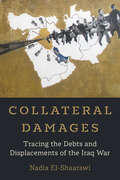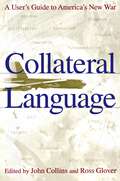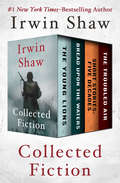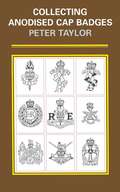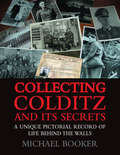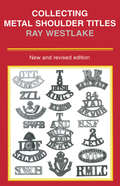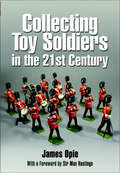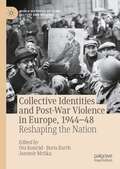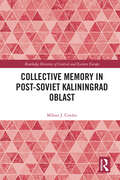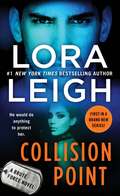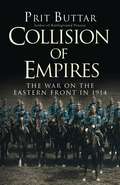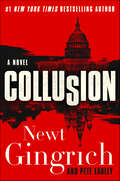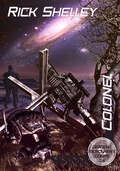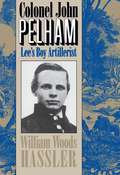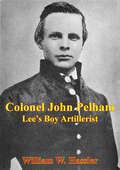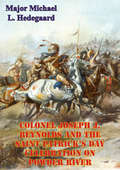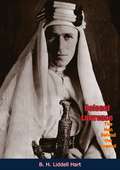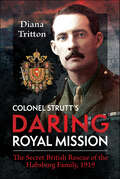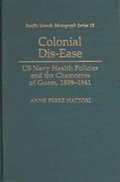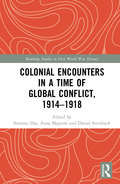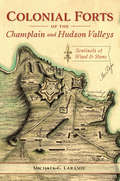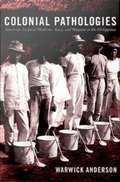- Table View
- List View
Collateral Damages: Tracing the Debts and Displacements of the Iraq War (California Series in Public Anthropology)
by Nadia El-ShaarawiMore than twenty years after the US-led invasion and occupation of Iraq, there has yet to be a meaningful public reckoning with the war. Collateral Damages brings Iraqi stories—which have been systematically excluded from dominant Western narratives of the war—to the fore. Drawing on a decade of ethnographic fieldwork, Nadia El-Shaarawi traces Iraqis' experiences of the 2003 invasion and the violence and displacement that followed, from urban exile in Cairo to efforts to rebuild by pursuing third-country resettlement—often in the very country responsible for them becoming refugees. Iraqis' theorizations of war and displacement illuminate how prevailing histories and memories of both the Iraq War and the larger Global War on Terror can be understood as imperial unknowing—epistemological and relational practices by which imperial power produces conditions of ignorance, hubris, obfuscation, and a willful turning away. Iraqis' accounts draw attention to that which empire prefers to keep hidden and offer possibilities for knowing the social and political effects of war differently.
Collateral Language: A User's Guide to America's New War (Studies In Security And International Affairs Ser. #33)
by John Collins Ross GloverThirteen essays contextualizing the new meanings around certain words and phrases in the post-9/11 discourseTerrorism, jihad, fundamentalism, blowback. These and other highly charged terms have saturated news broadcasts and everyday conversation since September 11th. But to keen ears their meanings change depending upon who's doing the talking. So what do these words really mean? And what are people trying to say when they use them?Each of the thirteen essays in Collateral Language offers an informed perspective on a particular word or phrase that serves as a building block in the edifice of post-World Trade Center rhetoric. In some cases this involves a systematic examination of the term in question (e.g. "anthrax" or "unity")its historical roots, the development of its meaning and usage in the U.S. over time, and its employment in the current context. In other cases authors provide a set of more philosophical or autobiographical reflections on a particular idea (e.g. "vital interests" or "evil"), suggesting a need to consider the ethical and moral implications of using the concept uncritically. In every instance, however, the overriding goal is to give the reader a set of practical tools to analyze the political language that surrounds all of us at this critical point in our nation's history. Witty, informative and highly readable, Collateral Language is a lexicon of political terminology and an indispensable tool for understanding the current conflict.
Collected Fiction: The Young Lions, Bread Upon the Waters, Short Stories: Five Decades, and The Troubled Air
by Irwin ShawThree acclaimed novels plus collected short fiction by the New York Times–bestselling author of Rich Man, Poor Man.The Young Lions: Irwin Shaw&’s New York Times–bestselling debut is widely considered one of the four great World War II novels, along with From Here to Eternity, The Naked and the Dead, and The Caine Mutiny. Ambitious in its scope and robust in its prose, this &“masterpiece&” is also deeply humanistic, presenting the reality of war as seen through the eyes of three ordinary soldiers: a Nazi sergeant, a Jewish American infantryman, and an idealistic urbanite from New York City (TheBoston Globe). Bread Upon the Waters: No good deed goes unpunished? The Strands are a happy family, though not without their financial struggles. When their daughter helps a mugging victim by bringing him home, he turns out to be a Wall Street lawyer whose gratitude is as boundless as his bank account. But with each successive &“reward,&” the Strand family moves farther away from the wealth of happiness they already possessed. Short Stories: Five Decades: Shaw&’s prolific output of short stories appeared regularly in the pages of the New Yorker and Esquire for over half a century. These sixty-three stories include such iconic works as &“The Eighty-Yard Run&” and &“The Girls in Their Summer Dresses.&” The Troubled Air: Five employees of Clement Archer&’s popular radio show are accused Communists. He will have to fire them to keep his show on the air. But it&’s not a simple choice—whatever Archer decides, he won&’t be able to keep his hands clean, in Shaw&’s provocative classic about courage and morality at the height of McCarthyism.
Collecting Anodised Cap Badges
by Peter TaylorAnodised cap badges were first produced in 1 948. This guide provides an illustration and listing for over 400 badges used by the British Forces. '
Collecting Colditz and Its Secrets: A Unique Pictorial Record of Life Behind the Walls
by Michael BookerFully illustrated with photographs and historical artifacts, this detailed history reveals what life was like inside the infamous Nazi POW camp. During the Second World War, the centuries-old Colditz castle took on an infamous new purpose. It became the site of Oflag IV-C, a prisoner of war camp designated for Allied officers who had escaped from other camps, including such famous names as Douglas Bader, Lorne Welch and Jack Best. This authoritative history reveals the secrets of the Sonderlager—or &“Special Camp.&” Historian Michael Booker draws on forty years of research into the subject, including interviews with former prisoners, as well as the German commandant Gerhard Prawitt and the head of security Captain Reinhold Eggers. He relates stories of British, Polish, and French prisoners, and their many and varied attempts to escape. These narratives are supported throughout with rare wartime photographs as well as a priceless collection of artifacts and memorabilia from the castle, some of which have never been seen before.
Collecting Metal Shoulder Titles
by Ray WestlakeA revised and updated collector’s reference guide to British Army metal shoulder titles from all the various units.Newly revised and updated, Collecting Metal Shoulder Titles records the titles worn throughout the British Army by units of the Regular, Militia, Yeomanry, Volunteer, Territorial and Cadet forces.Details of some two thousand patterns are set out in the text and illustrated by photographs from the author’s unique collection.Ray Westlake is a recognised authority on British Army lineage and gives dates of formation, amalgamation, disbandment and changes in designation for all regiments.Collecting Metal Shoulder Titles is recognised by collectors and military historians alike as the definitive reference work.Today, some sixteen years after it first appeared, the book remains the only reliable guide to an increasingly popular form of collecting.This edition, with two supplements, brings it abreast of the last round of mergers and amalgamations.
Collecting Toy Soldiers in the 21st Century
by James Opie Sir Mark HastingsA completely updated edition of the classic guide, by a leading authority in the field: &“For the toy soldier collector, an absolute must have.&”—Miniature Wargames James Opie&’s highly popular Collecting Toy Soldiers was an inspiration for anyone involved in the hobby. Decades later, this is a completely new companion updating the experience for the twenty-first century collector. James now gives the reader the benefit of his long experience as one of the world&’s leading authorities on toy soldiers, figures, and models, and a lifetime as a passionate collector himself. Collecting Toy Soldiers in the 21st Century contains comprehensive advice on all aspects of collecting, fully illustrated with new pictures. Guidance for every budget includes price trends and pitfalls to avoid when buying or selling at auction, at shows, online, or privately. Sharing informative and often-amusing anecdotes, James illustrates just how satisfying it can be to explore this blend of history, tradition, nostalgia, and play, whether on the grandest scale or with the most limited of funds.
Collective Identities and Post-War Violence in Europe, 1944–48: Reshaping the Nation (World Histories of Crime, Culture and Violence)
by Ota Konrád Boris Barth Jaromír MrňkaThis book analyses the process of ‘reshaping’ liberated societies in post-1945 Europe. Post-war societies tried to solve three main questions immediately after the dark times of occupation: Who could be considered a patriot and a valuable member of the respective national community? How could relations between men and women be (re-)established? How could the respective society strengthen national cohesion? Violence in rather different forms appeared to be a powerful tool for such a complex reshaping of societies. The chapters are based on present primary research about specific cases and consider the different political, mental, and cultural developments in various nation-states between 1944 and 1948. Examples from Italy, France, Norway, Denmark, Greece, Ukraine, Lithuania, Belarus, Czechoslovakia, and Hungary demonstrate a new comparative and fascinating picture of post-war Europe. This perspective overcomes the notorious East-West dividing line, without covering the manifold differences between individual European countries.
Collective Memory in Post-Soviet Kaliningrad Oblast (Routledge Histories of Central and Eastern Europe)
by Miłosz J. CordesThis volume presents the way the discourse of memory and identity in the post-Soviet territory of Kaliningrad Oblast has altered over time, examining the ways in which politically motivated German myths about East Prussia, which emerged after the unification of Germany in 1871, were reused and adapted after 1991 and the role the region has played in wider memory policies of the Russian Federation, particularly since Vladimir Putin’s third presidential term began in 2012.Kaliningrad Oblast is Russia’s westernmost region, maintaining a direct maritime but no land connection with the rest of the country. The region was part of East Prussia, which became a crucial element of the German national mythology after 1871. In 1945, East Prussia became one of the Soviet Union’s most important war trophies. Ever since, its complex political, cultural, ethnic, and religious history has presented a challenge to the central Soviet and Russian authorities. Ever since the emergence of a deep internal crisis in the Soviet system in the 1980s, the role of the Oblast’s past has been subject to intense public debate, reflecting the intricacies of post-Soviet Russian memory politics.Collective Memory in Post-Soviet Kaliningrad Oblast is intended for scholars interested in collective memory in the post-Soviet space, as well as the role that the history Kaliningrad Oblast has played in establishing the so-called neoconservative narrative in today’s Russia.
Collision Point: A Brute Force Novel (Brute Force Ser. #1)
by Lora LeighFrom #1 bestselling author Lora Leigh comes Collision Point, part of the thrilling Brute Force series—packed with powerful men, steely women, and explosive passion.SHE’S NOTHING BUT TROUBLERiordan Malone is more than a bodyguard. As an Elite Ops agent, he’s ripped, raged, and ready to rumble—a true warrior, inside and out. But no war zone can compare to the battle in Rory’s heart when he lays eyes on the only woman he’s ever loved—and thought he had lost forever. . . HE’S EVERYTHING SHE NEEDS As the daughter of a crime lord, Amara Resnova has endured the cruelty of her father’s enemies—and has tried to escape that world ever since. Now, she must reach out to the one man who saved her life, even if she’s never forgiven him for breaking her heart. But Amara is tougher today than she was then. She’s also more desirable to Rory—and dangerous to love. Can he protect her from her father’s enemies without surrendering to his own passions…or will love seal their fate for good?
Collision of Empires
by Prit ButtarImperial Germany, Hapsburg Austria-Hungary, and Tsarist Russia clashed on a scale greater than the Western Front campaign to the Marne and the Race to the Sea in 1914.Drawing on first-hand accounts and detailed archival research, this is a dramatic retelling of the the tumultuous events of the first year of World War I on the Eastern Front, with the battles of Tannenberg and the Masurian Lakes in East Prussia, followed by the Russo-Austrian clashes in Galicia and the failed German advance towards Warsaw.With the centenary of the start of World War I in 2014, Collision of Empires is a timely re-discovery of the bitter fighting on this forgotten front. The fighting that raged from East Prussia, through occupied Poland, to Galicia and the Carpathian Mountains was every bit as bloody as comparable battles in Flanders and France, but - with the exception of Tannenberg - remains relatively unknown. As was the case in the West, generals struggled to reconcile their pre-war views on the conduct of operations and how to execute their intricate strategic plans with the reality of war. Lessons were learned slowly while the core of trained personnel, particularly officers and NCOs, in the armies of Germany, Austria-Hungary and Russia suffered catastrophic losses throughout 1914. Inadequacies in supply and support arrangements, together with a failure to plan for a long war, left all three powers struggling to keep up with events. In addition, the Central Powers had to come to terms with the dreaded reality of a war on two fronts: a war that was initially seen by all three powers as a welcome opportunity to address both internal and external issues, would ultimately bring about the downfall of them all. Prit Buttar, author of Battleground Prussia, provides a magisterial account of the chaos and destruction that reigned when three powerful empires collided.
Collision with Chronos
by Barrington J. BayleyThe alien ruins that dotted Earth's landscape were an enigma.Archaeologist Rond Heshke dismissed as a ridiculous hoax the photographic evidence which suggested that the ruins disobeyed the laws of time. The Titanium Legions believed that the ruins had been left behind by an invading force from space, which had been repelled in a past age and whose imminent return was feared.It was not until the Titanium scientists perfected their time machines that the truth began to emerge piece by piece: that the builders of the ruins belonged not to the stars but to Earth's own future, and that the dreaded confrontation was indeed shortly due - not with aliens, but in a form more horrifying, more calamitous, than anything imaginable...For Earth was to be the victim of an extraordinary cosmic accident. Time itself was about to collide! Mankind's leaders became even more fanatical, pressing on with new plans, determined at all costs to survive...
Collusion: A Novel (Mayberry and Garrett #1)
by Newt Gingrich Pete EarleyNow a National Bestseller!What if the Russians really are colluding with Americans...on the left?#1 New York Times bestselling author Newt Gingrich makes his return to political fiction with this rollicking tale of high-stakes international intrigue—the first book in a new, contemporary series, filled with adventure, betrayal, and politics—that captures the tensions and divides of America and the world today.Valerie Mayberry is the FBI’s counterintelligence expert on domestic terrorism.Brett Garrett is a dishonorably discharged ex-Navy SEAL, now a gun for hire, working as a security contractor in Eastern Europe. When a high ranking Kremlin official must be smuggled out of Russia, Mayberry and Garrett are thrown together to exfiltrate him and preempt a deadly poisonous strike.As these unlikely partners work to protect their human asset, their mission is threatened by domestic politics: leftist protests, congressional infighting, and a culture riven by hatred. Collusion raises many of the most significant issues facing America in real life today. How big a threat is Russia? Are American leftist activists susceptible to influence from abroad? How far will our enemies go to disrupt our politics and weaken the nation? Can we trust the media to differentiate between the good guys and the bad guys? Newt Gingrich and Pete Earley have entertained and educated readers with three previous works. From its explosive opening through several twists and turns to its heart-stopping end, Collusion is their most timely and powerful novel yet.
Colonel (Dirigent Mercenary Corps #6)
by Rick ShelleyExplosive space combat as a soldier faces his final battle—from the national bestselling author of the Federation War series.The year is 2804 AD. Humanity has colonized the universe. But the authority of the Confederation of Human Worlds is spread thin. Where the army of planet Earth cannot reach, mercenaries must keep the peace—and the Dirigent Mercenary Corps are the best of the best.As a young cadet, all Lon Nolan ever dreamed of was serving in the military of planet Earth. After a dishonorable discharge on trumped-up charges, he saved himself and his honor by joining up with the Dirigent Mercenary Corps. Over the decades he’s forged himself a place with the DMC—and shown himself to be a true hero. There’s even talk that he might become the next General.But Lon isn’t after a promotion—in fact, he’s thinking about retirement. With his son in the Corps, he’s hoping he can leave the fighting to the next generation. But when the political machinations of the Confederation of Human Worlds get in the way, Lon has to return to the front lines, leading not just his troops, but his son among them, into a final bitter campaign.“Rick Shelley was a soldier at heart, and his books were written from the heart. They carry the real feel of the sweat, blood, and camaraderie of those on the front lines.” —Jack Campbell, New York Times–bestselling author“Rick Shelly knows how to write compelling military science fiction thrillers that are so action packed, readers hardly have a moment for an oxygen break.” —AllReaders.com
Colonel Chabert (The World At War)
by Honoré BalzacLe Colonel Chabert (English: Colonel Chabert) is an 1832 novella by French novelist and playwright Honoré de Balzac (1799–1850). It is included in his series of novels (or Roman-fleuve) known as La Comédie humaine (The Human Comedy), which depicts and parodies French society in the period of the Restoration (1815–1830) and the July Monarchy (1830–1848). This novella, originally published in Le Constitutionnel, was adapted for six different motion pictures, including two silent films. (Excerpt from Wikipedia)
Colonel Effingham's Raid
by Berry FlemingSatire at its gentlest and best and humor at its richest mark this story of a blustery retired military officer who mounts his final campaign against those self-appointed and elected guardians of the public good (and the taxpayer's purse strings) who are guilty of the sort of petty graft and private enrichment endemic in the mythical, sleepy, southern town of Fredricksville, Georgia.
Colonel John Pelham
by William W. HasslerEven before the end of the Civil War Colonel John Pelham had become a legendary figure of the Confederacy. General Lee called him "the gallant Pelham," and on seeing the young artillerist employ but a single gun to hold up the advance of three Union divisions and over a hundred guns at Fredericksberg, he exclaimed: "It is glorious to see such courage in one so young.""Stonewall" Jackson, who relied implicitly on Pelham in tight situations said: "It is really extraordinary to find such nerve and genius in a mere boy. With a Pelham on each flank I believe I could whip the world.""Jeb" Stuart, the dashing cavalry chief, claimed that "John Pelham exhibited a skill and courage which I have never seen surpassed. I loved him as a brother."Major John Esten Cooke, a fellow-officer and tent-mate, wrote: "He is the bravest human being I ever saw in my life."And one of Pelham's veteran gunners asserted: "We knew him -- we trusted him -- we would have followed him anywhere, and did."Shortly after the outbreak of hostilities in the spring of 1861, Cadet Pelham slipped away from West Point to join the Confederacy. Following the fierce Battle of First Manassas, in which he fought side-by-side with "Stonewall" Jackson, Pelham was assigned to "Jeb" Stuart's command with orders to organize the Stuart Horse Artillery. This mounted unit -- dashing from action to action on the battlefield -- provided General Lee's army with invaluable mobile firepower which saved many desperate situations.In over sixty battles Pelham's blazing guns saw furious action against Union infantry, cavalry, artillery, gunboats and even locomotives. Although he fought against tremendous odds, Pelham never lost an artillery duel or a single gun!Colonel Pelham was an outstanding figure on the battlefield and off. The modest, boyish-looking commander of the Horse Artillery was as calm and popular with his gunners under fire as he was with beautiful Southern belles in the ballroom. This action-packed book fully describes the incredible feats of the adventurous, romantic artillery genius of the Confederacy.
Colonel John Pelham: Lee's Boy Artillerist [Illustrated Edition]
by William W. HasslerIncludes more than 30 maps, diagrams and portraits of Pelham, his artillery and his commanders."Even before the end of the Civil War Colonel John Pelham had become a legendary figure of the Confederacy. General Lee called him "the gallant Pelham," and on seeing the young artillerist employ but a single gun to hold up the advance of three Union divisions and over a hundred guns at Fredericksberg, he exclaimed: "It is glorious to see such courage in one so young.""Stonewall" Jackson, who relied implicitly on Pelham in tight situations said: "It is really extraordinary to find such nerve and genius in a mere boy. With a Pelham on each flank I believe I could whip the world.""Jeb" Stuart, the dashing cavalry chief, claimed that "John Pelham exhibited a skill and courage which I have never seen surpassed. I loved him as a brother."Major John Esten Cooke, a fellow-officer and tent-mate, wrote: "He is the bravest human being I ever saw in my life."And one of Pelham's veteran gunners asserted: "We knew him-we trusted him-we would have followed him anywhere, and did."Shortly after the outbreak of hostilities in the spring of 1861, Cadet Pelham slipped away from West Point to join the Confederacy. Following the fierce Battle of First Manassas, in which he fought side-by-side with "Stonewall" Jackson, Pelham was assigned to "Jeb" Stuart's command with orders to organize the Stuart Horse Artillery. This mounted unit-dashing from action to action on the battlefield-provided General Lee's army with invaluable mobile firepower which saved many desperate situations.In over sixty battles Pelham's blazing guns saw furious action against Union infantry, cavalry, artillery, gunboats and even locomotives. Although he fought against tremendous odds, Pelham never lost an artillery duel or a single gun!This action-packed book fully describes the incredible feats of the adventurous, romantic artillery genius of the Confederacy."-Print Ed.
Colonel Joseph J. Reynolds And The Saint Patrick’s Day Celebration On Powder River;: Battle Of Powder River (Montana, 17 March 1876) (Montana, 17 March #1876)
by Major Michael L. HedegaardThe Battle of Powder River occurred on 17 March 1876 in southeastern Montana. Historians and researchers have consistently overlooked the importance of this battle on the outcome of the Great Sioux War of 1876. Colonel Joseph J. Reynolds set out to destroy the Indian camp established by the combined Cheyenne and Oglala Sioux in order to push the Indians back to the reservations and allow miners to enter the Black Hills to mine gold. Reynolds failed to accomplish this mission. The intelligence from his Indian scouts was flawed. Logistically, the soldiers were not fed, clothed, armed, or supplied for actions against the Indian tribes during the winter months. There was no written doctrine for the soldiers to follow. Tactically, Crook was delinquent because of the overconfidence in his force against the Indians. Crook failed to support Reynolds with troops, ammunition, logistics, and supplies. The outcome of this battle contributed to the defeats of Crook at the Rosebud and Custer at Little Big Horn because it caused the Indians to form a massive nation for self-preservation. Historians estimate that Crook faced more than 1,500 warriors at the Rosebud and Custer faced more than 2,500 braves at the Little Big Horn.
Colonel Lawrence, The Man Behind the Legend
by B. H. Liddell Hart“There have been other books about Colonel Lawrence, but none so solid as this…Captain Liddell Hart is a serious historian, a zealous seeker for and sifter of evidence, and a military critic of the first order…As biography it is as nearly full, honest, and plain-spoken as any biography of a living man can be; as history it is important… An impressive and convincing portrait as well as an extremely exciting narrative. Lawrence is here represented as a Pilgrim of Eternity, a man of universal capabilities, who, when in action, cannot escape general meditation, and when in retreat has to fight the thirst for action. His post-war seclusion is very simply explained: he had done a tremendous job under tremendous strain, had conducted with great genius the Desert War, had seen to it that our promises to the Arabs were implemented as fully as they could be, and needed a rest. There was no rest possible at Oxford where he tried a resident Fellowship of All Souls, and was deluged with callers. There would have been nothing but irritation in being a serving subordinate officer passing on orders in which probably he would not believe. He had to be in supreme command or at the bottom, where orders are received and none transmitted, so a private he became.”—Sir John Squire in the Sunday Times“By far the best book that has yet appeared about Colonel Lawrence and the Arab Revolt. It is a brilliantly illuminating study at once of a man and a campaign.”—The Daily Mail
Colonel Strutt's Daring Royal Mission: The Secret British Rescue of the Habsburg Family, 1919
by Diana TrittonFour Empires were extinguished by the Great War 1914-18 – the Ottoman, German, Russian and Austro-Hungarian. This is the story of the rescue of one of these Imperial families – the Habsburgs, who might well have suffered the fate of the Romanovs without the intervention of one British officer sent in secret by King George V of England. In January 1919, Lt. Colonel Edward Lisle Strutt, laden with medals and decorations, was on his way home from the Eastern Front when he was waylaid and ordered to Austria. He was irate when he learned the nature of his mission and tried to refuse. How could they ask him to give aid to the enemy he had just spend four miserable years fighting? To his great surprise he was to change his mind when he met and became enthralled by Zita Empress of Austria-Hungary. Thereafter, he was hers to command despite the danger to his life and career. Fortunately for us he kept a diary of the next three months which was lodged in the Royal archive at Windsor where it lay forgotten for the next 70 years. This is one of the great adventure stories of the Great War and Col. Strutt deserves to be better known.
Colonial Dis-ease: US Navy Health Policies and the Chamorros of Guam, 1898-1941
by Anne Perez HattoriExamines U.S. military colonialism through the lens of Western medicine and its cultural impact.
Colonial Encounters in a Time of Global Conflict, 1914–1918 (Routledge Studies in First World War History)
by Santanu Das Anna Maguire Daniel SteinbachThis volume gathers an international cast of scholars to examine the unprecedented range of colonial encounters during the First World War. More than four million men of color, and an even greater number of white Europeans and Americans, crisscrossed the globe. Others, in occupied areas, behind the warzone or in neutral countries, were nonetheless swept into the maelstrom. From local encounters in New Zealand, Britain and East Africa to army camps and hospitals in France and Mesopotamia, from cafes and clubs in Salonika and London, to anticolonial networks in Germany, the USA and the Dutch East Indies, this volume examines the actions and experiences of a varied company of soldiers, medics, writers, photographers, and revolutionaries to reconceptualize this conflict as a turning point in the history of global encounters. How did people interact across uneven intersections of nationality, race, gender, class, religion and language? How did encounters – direct and mediated, forced and unforced – shape issues from cross-racial intimacy and identity formation to anti-colonial networks, civil rights movements and visions of a post-war future? The twelve chapters delve into spaces and processes of encounter to explore how the conjoined realities of war, race and empire were experienced, recorded and instrumentalized.
Colonial Forts of the Champlain and Hudson Valleys: Sentinels of Wood & Stone
by Michael G. LaramieFrom Montreal to New York City, the rivers and lakes of the Hudson and Champlain Valleys carved a path through the primeval forests of the Northeast. The rival French and English colonies on either end built strategic strongholds there throughout the seventeenth and eighteenth centuries. The establishment of Fort St. Frederic at Crown Point gave the French command over the vital Lake Champlain. The French and Indian War saw the construction of frontier forts such as the English Fort William Henry at the headwaters of Lake George. Fortifications sometimes changed hands and names, such as when French-built Fort Carillon became the famed Fort Ticonderoga after a successful English siege. Author Michael G. Laramie charts the attempts to secure the most important chain of waterways in early North America.
Colonial Pathologies: American Tropical Medicine, Race, and Hygiene in the Philippines
by Warwick AndersonColonial Pathologies is a groundbreaking history of the role of science and medicine in the American colonization of the Philippines from 1898 through the 1930s. Warwick Anderson describes how American colonizers sought to maintain their own health and stamina in a foreign environment while exerting control over and "civilizing" a population of seven million people spread out over seven thousand islands. In the process, he traces a significant transformation in the thinking of colonial doctors and scientists about what was most threatening to the health of white colonists. During the late nineteenth century, they understood the tropical environment as the greatest danger, and they sought to help their fellow colonizers to acclimate. Later, as their attention shifted to the role of microbial pathogens, colonial scientists came to view the Filipino people as a contaminated race, and they launched public health initiatives to reform Filipinos' personal hygiene practices and social conduct. A vivid sense of a colonial culture characterized by an anxious and assertive white masculinity emerges from Anderson's description of American efforts to treat and discipline allegedly errant Filipinos. His narrative encompasses a colonial obsession with native excrement, a leper colony intended to transform those considered most unclean and least socialized, and the hookworm and malaria programs implemented by the Rockefeller Foundation in the 1920s and 1930s. Throughout, Anderson is attentive to the circulation of intertwined ideas about race, science, and medicine. He points to colonial public health in the Philippines as a key influence on the subsequent development of military medicine and industrial hygiene, U. S. urban health services, and racialized development regimes in other parts of the world.
